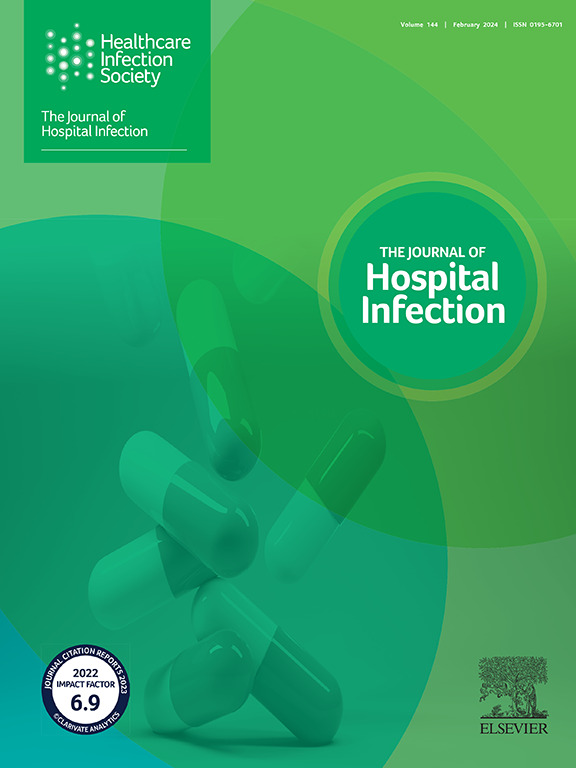两步法还是一步法--新生儿培养箱净化的所有方法都一样吗?
IF 3.9
3区 医学
Q1 INFECTIOUS DISEASES
引用次数: 0
摘要
导言:新生儿重症监护室(NICU)中与医疗保健相关的病原体(包括头状葡萄球菌)可能会污染培养箱表面,这也是新生儿重症监护室(NICU)非常关注的问题。有效的培养箱净化对于预防和控制感染至关重要,通常建议采用浸没式净化。但这并非总能实现,擦拭净化被视为一种替代方法。在此,我们比较了两步法(浸泡在酶洗涤剂中,然后用次氯酸盐抹布擦拭)和一步法(用浸渍季铵化合物的抹布擦拭)净化程序去除新生儿培养箱表面微生物替代标记物的能力:在两台 Giraffe™ Omnibed™ Carestation™ 培养箱的风扇、床垫接缝和外臂端口门夹上接种三种由菜花花叶病毒衍生的微生物替代标记。培养箱采用一步法或两步法净化。从每个培养箱和周围环境的 28 个部位采集拭子样本,并通过 qPCR 确定是否存在标记物:结果:经过两步净化后,有 3/28 个样本点(11%)的任何标记物呈阳性,而经过一步净化后,有 12/28 个样本点(43%)的任何标记物呈阳性。一步净化后,标记物转移到多个培养箱表面,并从最初接种的部位恢复,其中接种在门夹上的标记物转移最多。接种在床垫上的标记物在两种净化策略下都能持续存在:讨论:仅通过一步除污法并不能完全清除培养箱表面的微生物替代标记物。两步净化是最有效的方法,能清除可浸没表面上的标记物,但不能清除床垫上的标记物。这些研究结果表明,在对培养箱进行终端净化后,微生物可能会继续存在,尤其是在床垫上,而且如果没有使用两步净化程序。这凸显了有效净化方法对减少培养箱表面微生物持续存在的重要性。本文章由计算机程序翻译,如有差异,请以英文原文为准。
Two-step or one-step – are all methods for neonatal incubator decontamination equal?
Healthcare-associated pathogens, including Staphylococcus capitis, can contaminate incubator surfaces and are of significant concern in neonatal intensive care units (NICUs). Effective incubator decontamination is essential for infection prevention and control, with submersion decontamination often recommended. This may not always be achievable, with wipe decontamination seen as an alternative. Here we compare the ability of a two-step (submersion in enzymatic detergent followed by wiping with hypochlorite-based wipes) with a one-step (wiping with quaternary ammonium compound-impregnated wipes) decontamination procedure to remove microbial surrogate markers from neonatal incubator surfaces. Three cauliflower-mosaic-virus-derived microbial surrogate markers were inoculated on to the fan, a mattress seam and the external arm port door clips of two Giraffe™ Omnibed™ Carestation™ incubators. Incubators were decontaminated either by the one-step or the two-step decontamination process. Swab samples were collected from 28 sites on each incubator and surrounding environment, with marker presence determined by qPCR. Following two-step decontamination, three of 28 (11%) sample sites were positive for any marker, compared with 12 of 28 (43%) after one-step decontamination. Markers were transferred to several incubator surfaces and recovered from the originally inoculated sites following one-step decontamination, with the marker inoculated on door clips having the greatest transfer. Markers inoculated on to the mattress persisted through both decontamination strategies. In conclusion, microbial surrogate markers were not completely removed from incubator surfaces by one-step decontamination alone. Two-step decontamination was the most effective method and removed markers from submergible surfaces, but not from the mattress. These findings indicate that micro-organisms can persist after incubator terminal decontamination, particularly on mattresses and when a two-step decontamination process is not used. This highlights the importance of effective decontamination practices to mitigate micro-organism persistence on incubator surfaces.
求助全文
通过发布文献求助,成功后即可免费获取论文全文。
去求助
来源期刊

Journal of Hospital Infection
医学-传染病学
CiteScore
12.70
自引率
5.80%
发文量
271
审稿时长
19 days
期刊介绍:
The Journal of Hospital Infection is the editorially independent scientific publication of the Healthcare Infection Society. The aim of the Journal is to publish high quality research and information relating to infection prevention and control that is relevant to an international audience.
The Journal welcomes submissions that relate to all aspects of infection prevention and control in healthcare settings. This includes submissions that:
provide new insight into the epidemiology, surveillance, or prevention and control of healthcare-associated infections and antimicrobial resistance in healthcare settings;
provide new insight into cleaning, disinfection and decontamination;
provide new insight into the design of healthcare premises;
describe novel aspects of outbreaks of infection;
throw light on techniques for effective antimicrobial stewardship;
describe novel techniques (laboratory-based or point of care) for the detection of infection or antimicrobial resistance in the healthcare setting, particularly if these can be used to facilitate infection prevention and control;
improve understanding of the motivations of safe healthcare behaviour, or describe techniques for achieving behavioural and cultural change;
improve understanding of the use of IT systems in infection surveillance and prevention and control.
 求助内容:
求助内容: 应助结果提醒方式:
应助结果提醒方式:


